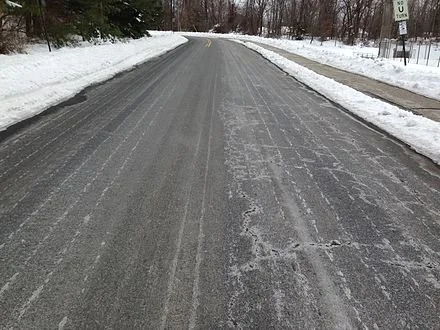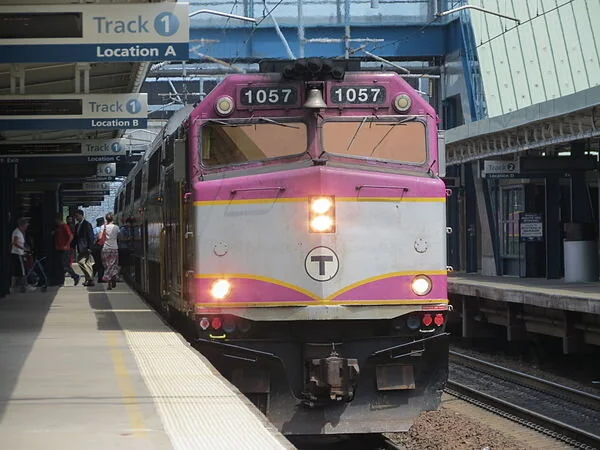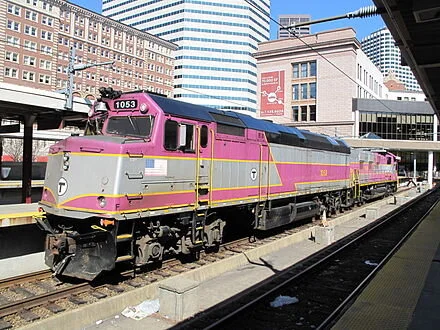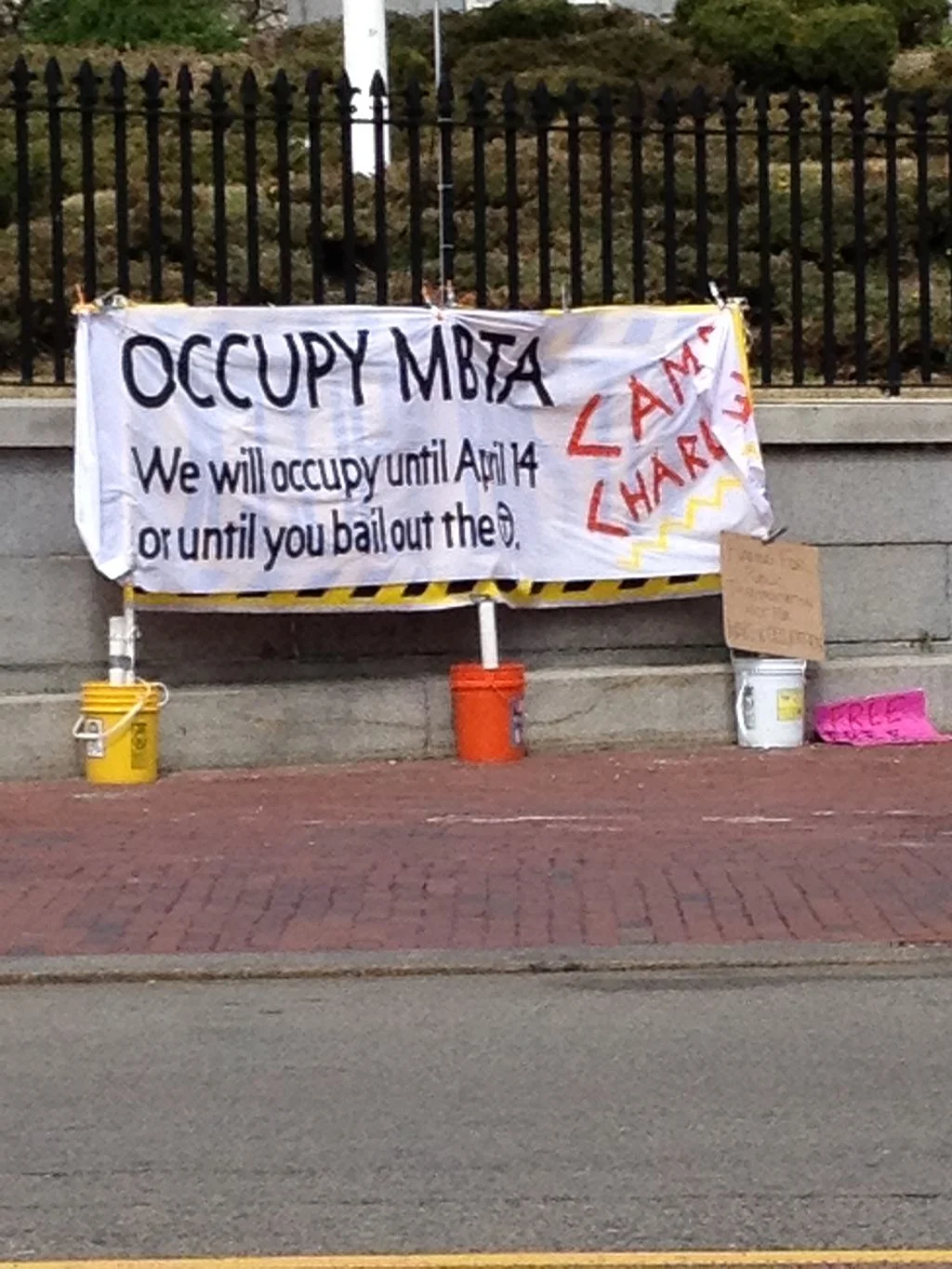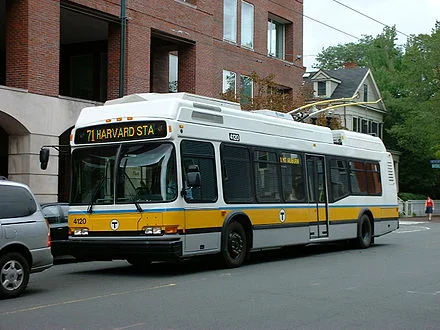
Use beets to battle ice
Brine sprayed on road before a snowstorm
Adapted from Robert Whitcomb’s “Digital Diary,’’ in GoLocal24.com
Now that real winter seems to be here, at least for a few days, let’s lobby cities and towns to go easier on pouring rock salt on the roads during and after ice and snowstorms. This stuff is highly corrosive and its runoff pollutes local water supplies. And it hurts the feet of animals and kills plants. Quite a few places are instead using a mix of beet extract (!) with brine. That’s been found to be a very effective melter and somewhat biodegradable.
Boston’s Planned West End Street Railway system, 1885; consolidation of these lines was complete by 1887.
The Feds are expected to approve a two-year experiment in free fares on several MBTA lines in Boston. That’s good news. Worcester’s experiment in free fares has been underway since the start of the pandemic and has just been extended another year. But trying it in a big city, with a dense public-transit system, such as Boston, is much more important.
A big question is how much savings from the resulting decline (if there is one) in car traffic, and thus less wear and tear, and fewer accidents, on the roads, can offset the loss of fare revenue? There would also be less air pollution. Give it a try!
Chilly New Englanders
Brother Jonathan, a 19th Century personification of New England, in striped pants, somber overcoat and Lincolnesque stove-pipe hat, as drawn by Thomas Nast. He is presented as wary and tight-fisted.
Adapted from Robert Whitcomb’s “Digital Diary,’’ in GoLocal24.com
“I never said, 'I want to be alone.' I only said 'I want to be let alone!' There is all the difference.’’
-- Greta Garbo (1905-1990), movie star, on her most famous quote, from Grand Hotel (1932)
An article in Commonwealth Magazine reports that new Boston Mayor Michelle Wu is disappointed that virtually no one on her MBTA Orange Line rides talks to her, even just to say hello.
She says:
“But we’ve got to change the culture of riding the T. It is a civic space for community conversations, but everyone’s always really quiet on there. Maybe I’m still a Midwesterner at heart.’’ The mayor was brought up near Chicago
To read the Commonwealth piece, please hit this link.
New Englanders tend to be reserved and guarded with strangers, unlike, say, in the South and West, where people tend to be very friendly to all, if often just superficially, like someone trying to sell you a car.
The unofficial New England flag, with its lonely pine.
It sort of reminds me of how in disasters, such as in tornado-ravaged Kentucky and other poverty-stricken “conservative’’ states, much is made of the good works of friendly churches and others in the private sector as opposed to aid from government (though Kentucky, a very poor state, is grabbing all the federal help it can now).
I’d rather have the much more impressive services provided by government in “socialist’’ New England than depend, say, on local churches (which are themselves subsidized by taxpayers because they’re tax-exempt – even the many ones that operate like political-party adjuncts).
Hit this link about Kentucky Sen. Rand Paul, a Republican, who voted for the huge Trump tax cuts while saying he’s terrified of the national debt but now wants as much federal aid as possible for his state. (Who wouldn’t?):
Paul has often opposed big federal disaster-relief programs that help states that don’t include Kentucky, including bills passed following hurricanes Sandy, Harvey and Maria.
More rail connections, please
Current MBTA commuter rail map
—By Das48
U.S. Rep. Stephen Lynch, of South Boston, to the State House News Service on what might be built if President Biden’s infrastructure bill is enacted.
“What I’m hoping is that with East-West Rail we might be able to make those western suburbs and outlying suburbs around Greater Boston more attractive places to live so people can get in and out of the city, and continue to work there and have a vibrant, vibrant community extending up into southern New Hampshire and down into Rhode Island and Connecticut. “We lose a lot of talent in Boston and New England because of housing prices. So if we can use that rail project to make the connection between workers that need more affordable housing and those nearby suburbs, I think that’s a great blueprint for the future.”
New MBTA commuter-rail schedule in effect
From The New England Council (newenglandcouncil.com)
“Keolis Commuter Services, which operates the MBTA’s commuter rail service, recently announced a new Spring 2021 schedule and improved services in efforts to better meet passenger needs. Some of the plan’s priorities include enhancing train frequency and interval predictability, allowing for greater consistency in train arrivals and departures, and providing extended service hours. In addition, the new changes seek to improve accessibility for essential and transit-critical workers, as well as less frequent riders.
“A collaborative effort between the MBTA and Keolis Commuter Services, the schedule took effect on April 5. It increases service significantly compared to the winter schedule, which had been in place since December 2020. Sanitation and social distancing will continue to be implemented in accordance with COVID-19 guidelines.
“The new Spring 2021 schedule provides options that our passengers have requested and can assist in a strong and equitable economic recovery with regular service across all lines and more consistent service to many gateway cities,” said Keolis Commuter Services CEO and General Manager David Scorey..
“The New England Council applauds Keolis Commuter Services’ commitment to passenger service and equity across all Boston transit lines. Read more from the Keolis Commuter Service press release.’’
MBTA commuter train serving the Providence/Stoughton Line at the Route 128 station
MBTA revisioning its trains
MBTA commuter train at South Station, Boston
From Robert Whitcomb’s “Digital Diary,’’ in GoLocal24.com
The MBTA will soon be changing its commuter-train and subway and bus schedules to not only save money but also to reflect how the lives of so many of us have been permanently changed by the pandemic.
Rush-hour commuting has much diminished in the pandemic and won’t return to its pre-COVID levels. That’s because many people will continue to work at home post-pandemic. Employers have found that they can get at least as much productivity out of their people working remotely as they could in company offices, while saving a lot in office costs. (Unfortunately, some of those costs are thrown onto the employees.) Further, many, maybe most, employees dislike commuting, which has been infamously unpleasant in Greater Boston. But some folks like commuting, for the solitude and thinking time it can give them.
Laboring at home has eroded the old 9-5 job routines, meaning for many longer but more fragmented working hours – and making many homes less of a psychological refuge.
In any event, train and subway travel will be more spread out during the day, and more of it will be non-work-related.
Commonwealth Magazine reports that the plan is to spread MBTA service out across the day at “regular, often hourly intervals rather than concentrating it at morning and evening peak periods.’’ Say hourly or half-hourly rail service between Providence and Boston and hourly service between Worcester and Boston. And some have suggested extending commuter-rail lines from Boston, say all the way out to Pittsfield and Springfield, or to Bourne, on the edge of Cape Cod.
Happily, the agency is dropping a plan to cut off commuter rail service at 9 p.m. weekdays, instead it will continue service until 11 p.m., important to, for example, many people attending a game or other evening event in Boston.
Whatever, as travel opens up with fading of the pandemic, let’s hope that the public-transit cutbacks that it has caused can be mostly reversed, to avoid a massive increase in automobile traffic, much of it with one person per car.
To read more about the MBTA changes, please hit this link.
Not wearing masks, not crowds, is the big peril
From Robert Whitcomb’s “Digital Diary,’’ in GoLocal24.com
Studies of some transit systems suggest that they’re not dangerous unless people don’t wear masks against COVID-19. Very crowded subway systems in Asia and Europe, where people are bumping up against each other, have not seeded pandemic outbreaks, because unlike in crazy Trumpian America, just about everyone wears a mask. Social distancing per se is overrated, as is that theatrical spraying with disinfectant.
Unfortunately, there’s no nationwide mask mandate for U.S. public transit, unlike in many other countries. It’s been politicized here, mostly because Trump supporters state their affiliation by refusing to wear masks, thus jeopardizing everyone else’s health.
Meanwhile, some states may have to declare harsh new lockdowns because of COVID seeding going on in bars, restaurants, colleges and public events.
The MBTA, by the way, is quite safe. Yes, I’ve used it recently to do business in Boston. It’s safer than driving into that city! But given how few people are using it, and the fact that conductors now sometimes don’t collect fares, the agency’s finances are in dire straits.
Trying to rebuild trust in public transport
On an MBTA Red Line platform at Boston’s Downtown Crossing station
From The New England Council (newenglandcouncil.com):
“Keolis was highlighted in Intelligent Transport for its role in providing and operating public transport in 15 countries worldwide in the age of a pandemic.
“In New England, Keolis operates the MBTA’s Commuter Rail system, which serves eastern Massachusetts and parts of Rhode Island. In the interview, CEO Bernard Tabary discusses the effects of the pandemic on transport and what Keolis is doing to rebuild public trust in transport solutions and the future of transportation worldwide.’’
Affleck had to get out of Boston, but Charlie couldn't
“I knew I had to get out of Boston and stop making movies there, at least for one movie, otherwise no one would ever consider me for a movie that took place south of Providence.’’
—Ben Affleck, film actor, director and screenwriter
“Did he ever return?
No he never returned
And his fate is still unlearn'd.
He may ride forever
'neath the streets of Boston
He's the man who never returned.’’
— From the song “Charlie on the MTA’’. The song was written in 1949 and became a national hit when recorded by The Kingston Trio, in 1959.
The lyrics tell of a man named Charlie trapped on Boston's subway system, once known as the Metropolitan Transit Authority (MTA, which also included buses), now the Massachusetts Bay Transportation Authority (which also includes commuter trains). The MBTA eventually named its electronic card-based fare- collection system the "CharlieCard" as a tribute to this song.
Baker tries to streamline transit improvements
— Photo by LuK3
From Robert Whitcomb’s “Digital Diary,’’ in GoLocal24.com
‘It takes much longer in the U.S. than in other developed nations to build and repair public infrastructure, as my old friend Philip K. Howard, who chairs Common Good, has researched, and written about so well, in such books as Try Common Sense.
The Massachusetts Bay Transportation Authority is in need of massive repairs and major subway and commuter train service expansion. So it was heartening to read that the public-private partnership aspect of Gov. Charlie Baker’s 10-year, $18 billion transportation plan includes provisions to streamline the procurement process.
The Boston Globe had an example of how stuff gets held up and things can be moved along at a faster clip.
“Most notably, the bill contains language aimed at avoiding what went down in Quincy last year: A development at the MBTA’s North Quincy Station ground to a halt after Attorney General Maura Healey ruled the T broke the law by not bidding out work for a parking garage that would be built there. A private developer was going to build the garage, but it would have ultimately been owned by the T.
“Baker’s bill would avoid another such situation by relaxing procurement rules to allow developers to move forward on a wide array of public transportation infrastructure — from staircases to stations — that would be part of their projects but deeded to the state or the MBTA. ‘’
One of the more interesting Baker administration proposals is to set up a new, $50 million program for a $2,000-per-employee tax credit for employers who let workers telecommute, thus reducing the pressure on Greater Boston’s often clogged roads during weekday rush hours. Of course, few managers would be affected.
To read more about the Baker plan, which of course would very much affect neighboring states, too, hit these links:
https://www.bostonglobe.com/business/2019/07/25/baker-transportation-bill-aims-encourage-public-private-partnerships/gC5V38s7pOzcv2uzoVshCJ/story.html
https://www.wbjournal.com/article/baker-seeks-arsenal-of-tools-in-18b-transportation-bond-bill
Vegas on the Mystic
From Robert Whitcomb’s “Digital Diary,’’ in GoLocal24.com
I doubt that the gigantic Encore casino complex on the Mystic River in Everett, that gritty old waterfront industrial city next to Boston, will steal much business from Twin River’s two Rhode Island casinos. Getting in and out of Boston, parts of which are often gridlocked, is too daunting, although I’m sure that many curious people from Greater Providence will check out Encore at least once. And it may lure a lot of tourists in Boston and Cambridge, e.g., people attending big medical and other professional meetings there who want some glitz and the adrenaline from gambling’s greed and fear, as well as very local gambling addicts who will henceforth spend much of their time in Everett, of all places, destroying their finances.
Meanwhile, maybe we’ll learn more about how to boost waterborne traffic in coastal cities by seeing how well Encore’s ferry service to the casino works.
Jim Folk, the casino’s transportation director, told WBZ: “It’s going to be great for the public. We’re going to actually be making connections from the South Shore where the MBTA runs service from Hingham and Hull into Boston and we can go and take those folks over from Boston to the North Shore.” Expand the epidemic!
The ferry will run seven days a week from about 7 a.m. to midnight on a triangular route connecting people to the casino, the World Trade Center, in the Seaport District, and Long Wharf downtown.
Fares will be $5-$7 depending on the route and will be open to the public, whether or not they’re going to the casino.
Anything to get people off the roads and the MBTA.
Keolis to resume MBTA weekend fare program
MBTA Commuter Rail locomotive at South Station.
This is from The New England Council:
“Keolis North America, a New England Council member, has announced that beginning this month it will resume the $10 Commuter Rail weekend fare pilot program in partnership with the Massachusetts Bay Transportation Authority. Keolis is contracted to operate the MBTA’s Commuter Rail system, which provides rail service throughout Greater Boston and into Rhode Island.
This program was first piloted during the summer of 2018, with the goal of increasing Commuter Rail ridership and revenue on the weekends. This initiative resulted in more than 180,000 tickets being sold, and very positive feedback from passengers. Like before, this special fare will cover the first train on Saturday to the last train on Sunday, and will apply across all zones and lines.
David Scorey, general manager and CEO of Keolis, said, “The MBTA’s reduced weekend fare initiative gives passengers a convenient and affordable option to visit a number of great destinations across the greater Boston area. We’re pleased to partner with the MBTA to continue this initiative that encourages new passengers to try Commuter Rail, helps to grow ridership, and promotes an environmentally friendly transit option.”
The future of the MBTA
lnside South Station, Boston, the major MBTA commuter rail hub.
From Robert Whitcomb’s ‘Digital Diary,’’ in GoLocal24.com
Rhode Island and Massachusetts readers would do well to read The Boston Globe’s Dec. 5 article “Mass. officials have big ideas – and big decisions – for the MBTA commuter rail’’. Bay State transportation officials are pondering how the system should change over the next few decades, including route and station additions, service frequency, fare structures and equipment. The many Rhode Islanders who commute on the MBTA to and from Boston, mostly from Providence but some from points south, should read the piece. Please hit this link
Democrats' takeover of House might presage greener light for Mass. rail-service expansion
The now-derelict place where the proposed Fall River MBTA station would go.
Adapted from Robert Whitcomb’s “Digital Diary,’’ in GoLocal24.com
Readers notice and maybe complain that I put a lot of public-transportation stuff in these columns. That’s because of its centrality in the prosperity of southern New England.
It’s good news for passenger-train expansion that the Democrats took the House in in mid-terms. Such pro-mass transit Massachusetts congressmen as Richard Neal and James McGovern will be in a position as committee chairmen to push for federal aid to boost such projects as rail service between Boston and Springfield and Boston and Fall River and New Bedford. Those would ease highway traffic and wear and tear on our roads, saving taxpayers time and money, and lift our region’s economy.
Purple lines show routes of proposed new MBTA lines to Fall River and New Bedford.
It will be tough to get anything helping New England through the GOP-controlled Senate, but a foundation (or rail bed) can be laid for when the political environment changes, perhaps after the 2020 elections.
Would Trump and the narrowly GOP Senate cooperate with the Democratic-run House in enacting a bill that would include the aforementioned projects? In his campaign, Trump talked up a huge infrastructure program but once in office pretty much dropped the subject and concentrated on giving himself and his pals a big tax cut and trying to kill the Affordable Care Act. But then the current version of the GOP sees tax cuts, particularly favoring the rich, as virtually their only domestic policy.
Still, a swelling federal deficit, an aging population, crumbling infrastructure and increased military spending pose huge challenges. My guess is that in the next few years, the top marginal federal income tax rate will have to be raised to around 50 percent to pay for the services the public wants (if not needs) and to address the rapidly swelling national debt and associated higher interest rates. The bond and stock markets are without mercy. We can’t live in financial Fantasyland forever.
Readers may email rwhitcomb4@cox.net to make comments.
Robert Whitcomb: Boston transit trials and triumphs
MBTA trolley bus.
From, Robert Whitcomb's Boston Diary, in The Boston Guardian, where a version of this piece first ran.
A little historical perspective is needed as we whine about MBTA delays and cancellations (especially during and after winter storms) and gridlocked street traffic.
The fact is that Boston has much better mass transit now than it had, say, three decades ago. Most importantly, there’s a lot more of it available. And for all their occasional breakdowns, the MBTA subway cars, trolleys, buses and commuter trains are generally in better condition than they were when I lived in Boston fulltime, almost 50 years ago. (These days I ride MBTA subways and commuter rail once or twice a month.)
And consider the South Station bus-train complex at the center of the MBTA empire: for decades a depressing, dirty domain for derelicts. Now it’s a spectacular intermodal center, served by more subway, commuter rail and bus lines than a generation ago, as well as by Amtrak’s semi-high-speed Acela. I love that the MBTA’s still newish Silver Line will take you directly to Logan Airport from the complex.
I can well remember when young having to wait for a bus across the street from South Station -- a creepy area dominated by the dubious Essex Hotel and frequented by panhandling bums, sexual predators and sexual businesspeople, among my other pals. (“Hey, cutie, have a light?’’) I had to take a bus because for a long time there were no trains to the South Shore, where I had relatives, the old New Haven Railroad having long since collapsed. Finally, the MBTA extended rail commuter lines down there.
And the burying of the Central Artery and related Big Dig work has often smoothed traffic and made downtown Boston more attractive and thus more prosperous.
The rebuilding/expansion of the Back Bay MBTA-Amtrak station will further improve life for transiteers. The station now is dank, dark and cave-like – an unsettling entry for travelers entering the gorgeous Copley Square neighborhood.
Now, if they could finally directly connect South and North Stations so that you could take an Amtrak or commuter train to north of Boston from south of it without having to get off at South Station and go to North Station by MBTA, cab or Lyft or Ube -- the current ridiculous situation. And more ferries, please, including on the Charles River.
Of course, Boston street traffic is often horrendous. That’s in part because the city has a dense public-transit system, which makes it more prosperous, which brings in more businesses and individuals, which clogs the streets and spawns the need for more mass transit, etc. At the same time, far, far too many people persist in driving their cars everywhere in this compact city.
Uber and Lyft have also worsened traffic, by putting many more vehicles on the road to serve cell-phone dependents who might otherwise have taken the subway, trolleys or buses. Boston needs to get many more people into transport that takes up much less room on the streets than all these cars with one passenger. That means we need more and better buses, not that I will ride in one.
Robert Whitcomb is president of The Boston Guardian, editor of New England Diary and a GoLocal24.com columnist.
Barry Schiller: A vision for better commuter rail service and links in southern New England
Via ecoRI News (ecori.org)
MBTA locomotives in South Station, the inbound terminus of commuter rail lines from the south of Boston.
We all know Rhode Island benefits from its proximity to Boston, which provides our residents and businesses access to markets, jobs, entertainment, medical services and schools. But we are held back by problems related to getting there and back.
The roads are increasingly congested, and that slows buses too. There are accidents, and parking can be tough. Highway improvements are sometimes environmentally destructive and very expensive. For example, the Rhode Island Department of Transportation may spend about $300 million just to redo less than a mile of I-95 in central Providence. And we know we should reduce gasoline consumption, which drains money out of the local economy and contributes so much to greenhouse-gas emissions.
Amtrak Acelas are quick, but also expensive. The Massachusetts Bay Transportation Authority (MBTA) commuter trains provide access and we are “on track” to add a Pawtucket-Central Falls station so that those communities can better access Boston and the rest of the state. The MBTA also brings Massachusetts folks to Rhode Island, including a significant number of “reverse commuters” without clogging our roads and Massachusetts folks also use it to get to our airport.
But the trains are relatively slow, often taking about 70 minutes to go the 44 miles from Providence to Boston. Though there are 20 trains each way weekdays, and there can be inconvenient gaps between trains, more than 2 hours apart at times. And the service isn’t very reliable about being on time.
So a regional group called Transit Matters has developed a vision for how the commuter rail could better serve the region’s economy and environment. After looking at best practices elsewhere, notably Philadelphia and Paris, its main recommendations include: electrification; high-level platforms at all stations; more frequent service; free transfers to local buses and subways; infrastructure improvements at a few bottlenecks.
On the Providence line, where there already are electric wires used by Amtrak, we would need additional wires in just a few stretches, notably the Pawtucket layover yard. That would make those nearby happy not to have diesel-engine pollution or noise. Electric engines are quieter and cleaner, and accelerate quicker, speeding up trips. They are more reliable and last longer than diesel. After startup capital costs they have lower operating costs.
High-level platforms, missing in eight of the current 15 stations on our line, also speed trips by quicker boarding at stations, especially for those with disabilities. The time to get to Boston could be reduced to about 46 minutes. Speedier trips use equipment and labor more efficiently and would also generate more revenue by attracting more passengers.
Long term, Transit Matters recommends a rail tunnel connecting North and South stations in Boston. This would have many operational advantages, avoid the need for an expensive expansion of South Station, and connect Rhode Island to the North Shore and northern New England, and connect them to us!
There are obstacles, including finding the capital funds to do all this, harder with the Trump administration hostility to both our region for not voting for him and to trains with their highly unionized workforce.
The environmental community, though interested in promoting electric cars, has mostly ignored electrifying our commuter rail. It’s also a challenge to get two states, the MBTA and the Rhode Island Public Transit Authority (RIPTA) to all work together and coordinate. But, there are a lot of benefits.
Barry Schiller, a transit rider and longtime transit advocate, is a former board member of the Rhode Island Public Transit Authority.
To work and to play with a water view
MBTA commuter boat in Boston Harbor.
From Robert Whitcomb's "Digital Diary,'' in GoLocal24.com
Whatever you think of the heavy government subsidy for the Providence-Newport summertime ferry, the service provides more than just a very pleasant way to travel between the two cities. With adequate promotion it could bring many more tourists to the region. And the service’s existence is a reminder of the big potential of traveling – including commuting – by water in densely populated Rhode Island, with so much water. In parts of Europe and Asia a place like Narragansett Bay would be crowded with ferry boats year round.Fr
Massachusetts Bay has long had successful year-round MBTA ferry service connecting Hingham and downtown Boston, although, of course, that’s a richer and more heavily populated area. Not to subsidize the Providence-Newport long enough so that it helps create a traveling habit and becomes a model for other ferry service around here would be a false economy. And wouldn’t drivers on Routes 95 and 195 prefer to have more people onboats and fewer on the roads?
Meanwhile, the small and unsubsidized Newport-Jamestown ferry service operated by Conanicut Marine Services suggests that there could eventually be a plethora of such services linking Narragansett Bay communities. The ferry has been particularly alluring in the past few weeks with reconstruction work on the Pell Bridge causing big delays.
Llewellyn King: Looking for a good pub; in praise of the MBTA; dearth of shoeshiners
NOTEBOOK
What makes a British pub a pub as opposed to a bar, café or cocktail lounge? It isn't, I hasten to mention, just the décor -- although the odd horse brass and a picture of a bulldog or two helps. It's how the establishment is used.
The trick is in the name “public house,” which could easily be interpreted as home away from home. The pub is an extension of your living room or office.
British friends will ask, “What’s your local?” or “Where do you drink?” Of course, the Brits are more likely to have a glass of something after work than are most Americans, these days.
When I lived in Richmond, a London borough, I drank at “The Cricketers,” and friends would meet me there. It wasn't about the drink; it was about the social context of a pub.
But here in New England, as befits our ancestry, you find the closest things to British pubs: cozy joints where friends hang out, nourished with beer, or not.
Thousands of New England bars function as pubs, not because they call themselves that, but because of a certain ambiance, a certain feeling that I'm already home.
As the Brits have changed, so have their pubs. Once, they were mostly owned by breweries and rented out to “landlords” who operated them. Now, more of them belong to chains and have standardized food. A “free house” was a pub that belonged not to the brewer or a chain, but to the landlord or a small company. These sold the beers of various brewers, like, say, Watneys, Bass and Theakston.
The biggest change has been the end of smoking. The pubs were often awful for nonsmokers. Now they are smoke-free -- although some have outdoor sheds, where you can still smoke, pint in hand. Otherwise, the drinkers spill into the street to light up. Mind you, British drinkers have always spilled into the street. Something you won’t find in New England pubs, probably because of licensing laws.
Another change was the addition of really good food in what have come to be known as “gastropubs.” I'd venture to say most New England pubs, worthy of that appellation, have pretty decent food.
The old British pub offered limited fare: pork pies, bangers, Scotch eggs and sandwiches. Now, more elaborate fare is available including excellent French meals, great Italian, and sometimes Chinese. At the latter, you may be offered French fries in lieu of rice. Really.
Recently, I chanced upon a New England pub that exactly fits the criteria established by its old English forebears: The Village Tavern in North Scituate, R.I. It has great food plus the ambiance of the real thing. It’s real to me.
Give the MBTA Its Due
I’m a fan of public transport in general, and of trains in particular. This extends to city systems and as a stranger to its peculiarities, but nonetheless a convert, I'd like to do the improbable: Praise the MBTA.
Too much of it is old, dirty and hard to navigate, but it works; whether it is the eccentric Silver Line from Boston to Logan International Airport (with its two versions of propulsion), or the subway proper, or the commuter lines. All cry out for investment, for kindly dollars for refurbishment and substantial rebuilding of the rabbit-warren stations.
But the MBTA mostly works, which can't be said of the modern and prettier Washington, D.C. Metro. It's in need of better maintenance, better management, and more trains at rush hours.
Let’s have two cheers for the MBTA which, like the New York system, isn’t easy on the eye, but mostly works.
The Strange Dearth of Shoeshine Stands
There are certain mysteries that confound me. Why can’t you find taxis cruising in Providence, is one. Another is why, throughout the region, is it so hard to get your shoes shined. Even at Boston’s busy South Station the happy slap of the cloth on the leather isn't heard. Most stations and airports have shoeshine stands.
Chicago has one somewhere – I forget where — that even boasts that it's unionized. But the fine art of shining shoes isn't developed in these parts.
Over the decades, I've interviewed shoeshiners, almost all men, from London to New Orleans. I can report that they're a happy breed.
It's low-end work, but the potential for self-employment is great. Washington, D.C. has men who set up all over the place, but not New England. A singular exception is Thomas McNees, the shoeshiner at Rhode Island's T.F. Green Airport. He's an institution and as cheery as he's good. Unfortunately, he's on the far side of the terminal's security barrier — and even I won’t buy an airline ticket to get a shoeshine.
Llewellyn King (llewellynking1@gmail.com) is executive producer and host of White House Chronicle, on PBS.
Abandon all hope ye who enter here
Route 128 in Canton, Mass.
Take cover! As part of a bridge project, Route 128 will be closed from the night of Nov. 4 through Nov. 6 in Needham, with trafficto be rerouted through local roads. Even though this will be on a weekend and with plenty of official warning, expect chaos! With all the whining about the MBTA, thank God that Greater Boston, unlike many U.S. metro areas, at least has a fairly dense mass-transit system to take pressure off the roads. If only it were denser.
-- Robert Whitcomb
Jim Stergios: Time to stop Boston mega-project mania
One of Goya's Titan paintings.
BOSTON
Last year it was a billion-dollar expansion of the Boston Convention and Exhibition Center, with an embedded $110 million giveaway to a hotel developer. This year it was the recently abandoned Boston 2024 Olympic bid. Now we’re talking about digging a tunnel to connect North and South Stations. Boston has a mega-malady, and it is a love affair with mega-projects.
Modern-day Massachusetts is acquiring a variant of French political sophistication, whereby Boston (Paris) is the showpiece and the rest of the state (France) is relegated to flyover status. Here are three quick facts to waken us from our dangerous flirtation with economic development in the grand continental style. The MBTA — buried under nearly $9 billion in debt and interest, and with a maintenance backlog of more than $7 billion — should focus on avoiding a replay of last winter’s horror story. A new tunnel does not make the MBTA’s list of top priorities.
Often lost in the heated discussions of particular parcels is the bigger question of what kind of a city we want to be. Cost realism has in the past reined in Boston’s appetite for megaprojects. In essence, that is what happened when the governor and legislative leaders commissioned a third-party evaluation of the Boston 2024 effort.
Former Gov. Michael Dukakis argues that the North-South Rail Link should be buildable for $2 billion, not the estimate of $8 billion. It should cost less, but it will cost more. We just learned that the Green Line extension is $1 billion over budget. No one has forgotten that the Big Dig was supposed to cost $2.8 billion, but ultimately broke the $15 billion sound barrier.
Cost estimates aren’t the only problem. Project benefits are routinely oversold. Exhibit A: The unrealistic pictures painted by convention center feasibility studies are legendary. The BCEC is doing between 30 and 40 percent of the business it was projected to do. Exhibit B: The Greenbush commuter rail line. Instead of, as projected, taking eight passengers off highways for each one lured from the MBTA’s South Shore commuter boat service, nearly half the current customers previously took the ferry. When those who rode other commuter rail lines are added in, more than 60 percent of Greenbush riders were already using public transit.
Rather than Boston’s mega-project megalomania, we need to return to a good old American sense of fair play. When Gov. Charlie Baker pulled the plug on the proposed BCEC expansion, he created an opportunity to do just that. Each year, tourism-related taxes generate tens of millions of dollars to underwrite the Massachusetts Convention Center Authority. Between now and 2034, these taxes will provide the MCCA with $30 million more annually than it needs to operate. After 2034, when the bonds sold to pay for the construction of the BCEC are paid off, that amount will more than double.
Anyone who has spent time in Massachusetts cities outside Boston knows that they have significant infrastructure needs, including roadways, retail spines, bridges, and sidewalks. For years the Big Dig left these cities starved of investment; it takes no sophistication to understand that the litany of Boston mega-project proposals would continue that trend.
Cost estimates aren’t the only problem.Project benefitsare routinely oversold. Infrastructure upgrades will not, by themselves, refashion the futures of Massachusetts’ cities. But together with reforms to public schools, policing, and economic policies, state investment can go a long way toward making them more attractive places to live and work. In fact, creating an infrastructure fund for these cities to leverage needed reforms would prove a powerful urban revitalization strategy.
Greater Boston needs its fair share of infrastructure investments — and right now MBTA upgrades are what can do the region the most good. State government must keep in mind, however, that more than half of the state’s population is outside Route 128. Forgoing an $8 billion Boston mega-project would allow infrastructure upgrades across Massachusetts.
Jim Stergios is executive director of the Pioneer Institute, a Boston-based think tank. This piece originated in The Boston Globe.

